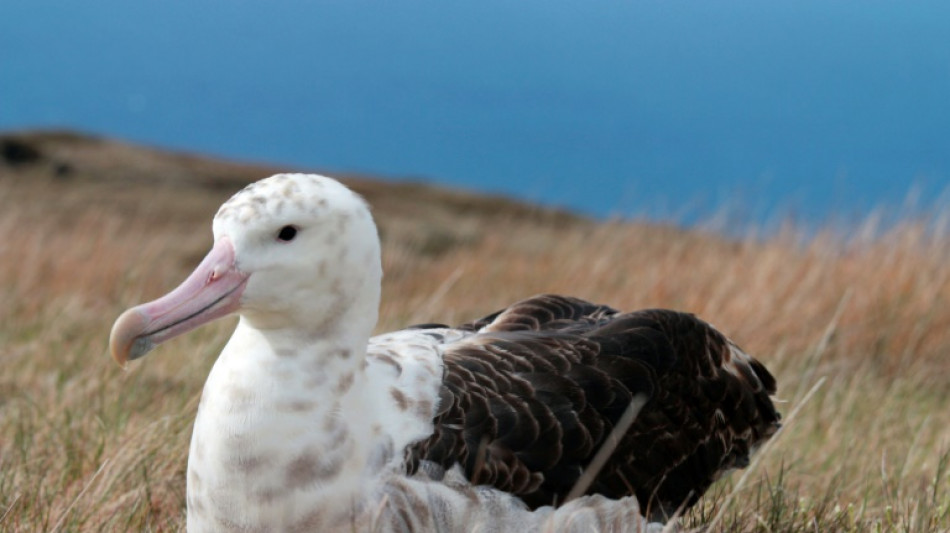
RBGPF
58.8300


Conservationists are workingto rid a remote French southern Indian Ocean island of rodents and stray cats by the end of next year to protect prized albatrosses and other birds.
We want "to eradicate all rats, cats and mice in the winter of 2024," said Lorien Boujot, in charge of managing invasive mammals on the UNESCO-listed Ile Amsterdam.
Roughly equidistant from Madagascar, Australia and Antarctica, the island is uninhabited except for a research station on its northern coastline.
But cats and rats introduced over the years by visiting ships "have been the main cause for the disappearance of around 10 species of nesting birds" from the cliffs and plateaus, Boujot said.
"Rats tend to prey on eggs or even chicks, while cats can attack them even when they reach adulthood."
The mammals may also spread avian cholera, likely brought to the island when chickens were kept there in the past, Boujot said.
"Now each year it plays havoc with the breeding of yellow-nosed albatrosses" living on the cliffs in the south of the island.
The French Austral Lands and Seas, including Amsterdam, have the largest population of yellow-nosed albatrosses in the world, according to UNESCO, which listed the reserve as a World Heritage site in 2019.
Mice too are a menace for the isle's flora.
They gobble up the flowers and seeds of indigenous plants such as Island Cape myrtle, a shrub that used to form a natural belt around the coast but is now struggling to survive.
Conservationists have tried to replant it, but "rats tend to eat and break the young plants", Boujout said.
- No more cats? -
The plan is to air-drop poison across the whole of the island's 55 square kilometres (20 square miles) during the Antarctic winter next year .
Scientists have been studying which species to target since 2017, according to Boujot, and will deploy the poison in winter to avoid missing juveniles in their nests during the reproduction season.
"The tricky thing is that if we miss one of the rodents' home ranges, the whole operation fails," he said.
Specialists Louis Gillardin and Brieuc Leballeur will this winter be on the lookout for stray cats and tasked with shooting or catching any in traps.
"Last year, our predecessors eliminated seven and for a month and a half or two months now we haven't seen any on the 40 or so camera traps" around the island, said Gillardin.
"I've never killed a cat in my life and wouldn't enjoy it. If they had in fact now disappeared, that would suit us."
His colleague Leballeur claimed traps he had set near the albatross colony had led to a decrease in chick mortality there.
The team will have to wait two years to see if any of the targeted mammals reappear before they can call the operation a success, Boujot says.
And only monitoring over a decade will be able to tell if lost bird species return to the island to nest.
Jeremy Tornos, a researcher at France's CNRS institute who wrote his PhD on the island's albatrosses, said he is looking forward to the results.
"We have seen a drop in chick survival since the 1980s," he said.
But after 2024, "We'll be able to see the impact of the rat, both as a predator and pathogen source.
"We don't yet know if rats carry avian cholera and transmit it to birds they bite, or whether they become carriers because they eat birds carrying it," he explained.
"A colony without rats will also allow us to test how efficient a vaccine really is" against the illness.
- Huge budget -
But the model is hard to replicate on nearby French islands such as Kerguelen, where rodents, cats, rabbits and reindeer are equally destructive.
"Eradication on Amsterdam means a budget of more than two million euros ($2 million) and years of work," said Clement Quetel, an official at the environment department for the French overseas territory.
On Kerguelen, "thinking about getting rid of mice -- which are almost everywhere -- would be impossible" logistically and financially, he said.
The same goes for its cats, which environment workers instead try to shoot or trap.
Vigilance will be needed in future to prevent new invasive mammals from making their way to these islands.
On a research ship travelling from island to island, Kevin Nory's job is to make sure there are no unwelcome animal stowaways on board.
Stepping deep into its bowels, he checked if rat poison he had laid out in about 30 traps had been eaten.
He said he had not found a single rodent on the boat since mid-2021.
"It's rather positive," he said.
(S.G.Stein--BBZ)